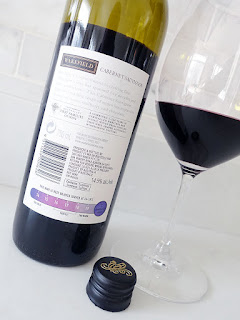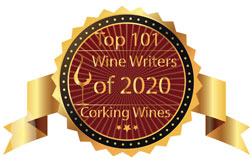Happy New Year! To start off 2026, white wine review is an excellent Semillon from the Barossa Valley in Australia. It arrived at the LCBO - along with its companion Shiraz - late last year in the LCBO VINTAGES New Release Collection, and both are readily available for purchase today.
It is produced by Torbreck Vintners, a wine producer that was established in the Barossa Valley by David Powell in 1994. The winery is named after a forest in Scotland where David worked as a lumberjack. Mr. Powell gained his winemaking experience at various Barossa wineries and was inspired to create his own label. He began to share-farm vineyards in order to obtain fruit from some of the Barossa Valley's very best vineyards. Torbreck takes its inspiration from France's Rhône Valley, while championing the rich viticultural heritage of the Barossa.
In 2008, Pete and Terri Kight entered into a partnership with Torbreck and eventually took over the business in 2013. Today, proprietors Pete and Terri are dedicated to establishing Torbreck among the world's leading wine producers. They remain focused on this journey by staying true to their core vision, rather than following trends or fashions. With provenance at its heart, the Barossa and its Mediterranean climate and 175 years of winemaking heritage provide an extraordinary foundation for Torbreck wines. While they have achieved much over the first three decades, their journey is far from complete as they continue to look forward.
Torbreck sources fruit from some of the finest vineyards in the Barossa, and they constantly seek to understand the difference between all of these special places. Moreover, they seek to understand how the fruit reacts to the seasons and how this combination of soil and climate and farming experience is reflected in unique grape flavours. This requires patience, as well as a gentle hand in the winemaking process. Torbreck respects the vineyard and the wine, as they are simply custodians. Led by General Manager and Chief Winemaker Ian Hongell, the team of experienced winemakers and viticulturists bring a deep understanding of the region's terroir and expertise to ensure that every bottle of wine reflects the artistry, intensity, and elegance for which Torbreck is renowned.
Semillon has always found a natural home in the Barossa, going back to when it was first planted by settlers around 160 years ago. It has succeeded in this area due to the Mediterranean climate and careful farming, to create a heritage of old, low-yielding Semillon vineyards. The Semillon for this wine is exclusively the age-old, robust, and pink-skinned Madeira clone, which is found mainly in the Barossa.
This white wine is crafted with 100% Semillon that was grown in the sub-regions of Rowland Flat, Ebenezer, and Lyndoch, within the Barossa Valley. The grapes were harvested throughout the month of February and traditionally vinified. The wine was matured for 3 months, with 60% in stainless steel tank and the remainder in seasoned French barrique. The resulting wine is reminiscent of the savoury white wines found in the central and southern regions of France.
The 2024 vintage in Barossa saw timely spring rainfall and calm conditions for flowering and fruit set. An idyllic summer featured mild to warm temperatures, which propelled even growth and fruit development. While yields were variable and below average, the quality is exceptional across the board. Let's see how this 2024 Semillon from the Barossa Valley is tasting tonight...
Screw cap enclosure. The restrained, medium+ intensity nose delivers attractive lemon citrus, white floral, and garden herb aromas accented with leesy minerals and a touch of spice. On the dry, medium+ bodied palate it is well-structured and ripe with lovely lemon citrus, grapefruit, white floral flavours joined by straw, paraffin, waxy, earthy mineral, and spice accents adding complexity. It has clean, crisp, and refreshing acidity, while the well-structured mid-palate is crisp with a slightly chalky textured mouthfeel. Spice and lemon citrus notes taper to savoury minerals on the crisp, and very long finish. Very youthful at this stage, this will gain further complexity and interest as it ages over the next dozen years. Highly recommended buy! Score: 92 pts
Quite a few wines by Torbreck are available on the LCBO, while the full range can be ordered through their Agent - Noble Estates Wines & Spirits.
It is produced by Torbreck Vintners, a wine producer that was established in the Barossa Valley by David Powell in 1994. The winery is named after a forest in Scotland where David worked as a lumberjack. Mr. Powell gained his winemaking experience at various Barossa wineries and was inspired to create his own label. He began to share-farm vineyards in order to obtain fruit from some of the Barossa Valley's very best vineyards. Torbreck takes its inspiration from France's Rhône Valley, while championing the rich viticultural heritage of the Barossa.
In 2008, Pete and Terri Kight entered into a partnership with Torbreck and eventually took over the business in 2013. Today, proprietors Pete and Terri are dedicated to establishing Torbreck among the world's leading wine producers. They remain focused on this journey by staying true to their core vision, rather than following trends or fashions. With provenance at its heart, the Barossa and its Mediterranean climate and 175 years of winemaking heritage provide an extraordinary foundation for Torbreck wines. While they have achieved much over the first three decades, their journey is far from complete as they continue to look forward.
Torbreck sources fruit from some of the finest vineyards in the Barossa, and they constantly seek to understand the difference between all of these special places. Moreover, they seek to understand how the fruit reacts to the seasons and how this combination of soil and climate and farming experience is reflected in unique grape flavours. This requires patience, as well as a gentle hand in the winemaking process. Torbreck respects the vineyard and the wine, as they are simply custodians. Led by General Manager and Chief Winemaker Ian Hongell, the team of experienced winemakers and viticulturists bring a deep understanding of the region's terroir and expertise to ensure that every bottle of wine reflects the artistry, intensity, and elegance for which Torbreck is renowned.
Semillon has always found a natural home in the Barossa, going back to when it was first planted by settlers around 160 years ago. It has succeeded in this area due to the Mediterranean climate and careful farming, to create a heritage of old, low-yielding Semillon vineyards. The Semillon for this wine is exclusively the age-old, robust, and pink-skinned Madeira clone, which is found mainly in the Barossa.
This white wine is crafted with 100% Semillon that was grown in the sub-regions of Rowland Flat, Ebenezer, and Lyndoch, within the Barossa Valley. The grapes were harvested throughout the month of February and traditionally vinified. The wine was matured for 3 months, with 60% in stainless steel tank and the remainder in seasoned French barrique. The resulting wine is reminiscent of the savoury white wines found in the central and southern regions of France.
The 2024 vintage in Barossa saw timely spring rainfall and calm conditions for flowering and fruit set. An idyllic summer featured mild to warm temperatures, which propelled even growth and fruit development. While yields were variable and below average, the quality is exceptional across the board. Let's see how this 2024 Semillon from the Barossa Valley is tasting tonight...
Tasting Note:
TORBRECK WOODCUTTER'S SEMILLON 2024 - Barossa Valley, South Australia (#927541) (XD) - $29.95Screw cap enclosure. The restrained, medium+ intensity nose delivers attractive lemon citrus, white floral, and garden herb aromas accented with leesy minerals and a touch of spice. On the dry, medium+ bodied palate it is well-structured and ripe with lovely lemon citrus, grapefruit, white floral flavours joined by straw, paraffin, waxy, earthy mineral, and spice accents adding complexity. It has clean, crisp, and refreshing acidity, while the well-structured mid-palate is crisp with a slightly chalky textured mouthfeel. Spice and lemon citrus notes taper to savoury minerals on the crisp, and very long finish. Very youthful at this stage, this will gain further complexity and interest as it ages over the next dozen years. Highly recommended buy! Score: 92 pts
Quite a few wines by Torbreck are available on the LCBO, while the full range can be ordered through their Agent - Noble Estates Wines & Spirits.














































